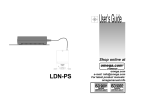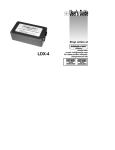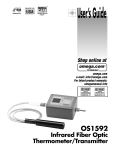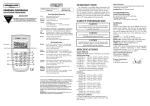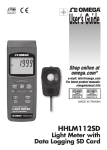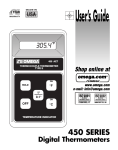Download Omega Engineering FPR 200 User's Manual
Transcript
User’s Guide Shop online at Flow Sensor with Polypropylene Body omega.com e-mail: [email protected] For latest product manuals: omegamanual.info ISO 9001 ISO 9002 CERTIFIED CORPORATE QUALITY CERTIFIED CORPORATE QUALITY STAMFORD, CT MANCHESTER, UK Flow Sensor with Stainless Steel Body FPR 200 Flow Sensor OMEGAnet ® Online Service omega.com Internet e-mail [email protected] Servicing North America: U.S.A.: ISO 9001 Certified Canada: One Omega Drive, Box 4047 Stamford, CT 06907-0047 Tel: (203) 359-1660 e-mail: [email protected] 976 Bergar Laval (Quebec) H7L 5A1, Canada Tel: (514) 856-6928 e-mail: [email protected] FAX: (203) 359-7700 FAX: (514) 856-6886 For immediate technical or application assistance: U.S.A. and Canada: Sales Service: 1-800-826-6342 / 1-800-TC-OMEGA® Customer Service: 1-800-622-2378 / 1-800-622-BEST® Engineering Service: 1-800-872-9436 / 1-800-USA-WHEN® TELEX: 996404 EASYLINK: 62968934 CABLE: OMEGA Mexico: En Espan˜ol: (001) 203-359-7803 FAX: (001) 203-359-7807 e-mail: [email protected] [email protected] Servicing Europe: Benelux: Postbus 8034, 1180 LA Amstelveen, The Netherlands Tel: +31 (0)20 3472121 FAX: +31 (0)20 6434643 Toll Free in Benelux: 0800 0993344 e-mail: [email protected] Czech Republic: Frystatska 184, 733 01 Karvina´, Czech Republic Tel: +420 (0)59 6311899 FAX: +420 (0)59 6311114 Toll Free: 0800-1-66342 e-mail: [email protected] France: 11, rue Jacques Cartier, 78280 Guyancourt, France Tel: +33 (0)1 61 37 2900 FAX: +33 (0)1 30 57 5427 Toll Free in France: 0800 466 342 e-mail: [email protected] Germany/Austria: Daimlerstrasse 26, D-75392 Deckenpfronn, Germany Tel: +49 (0)7056 9398-0 Toll Free in Germany: 0800 639 7678 e-mail: [email protected] FAX: +49 (0)7056 9398-29 United Kingdom: One Omega Drive, River Bend Technology Centre ISO 9002 Certified Northbank, Irlam, Manchester M44 5BD United Kingdom Tel: +44 (0)161 777 6611 FAX: +44 (0)161 777 6622 Toll Free in United Kingdom: 0800-488-488 e-mail: [email protected] It is the policy of OMEGA Engineering, Inc. to comply with all worldwide safety and EMC/EMI regulations that apply. OMEGA is constantly pursuing certification of its products to the European New Approach Directives. OMEGA will add the CE mark to every appropriate device upon certification. The information contained in this document is believed to be correct, but OMEGA accepts no liability for any errors it contains, and reserves the right to alter specifications without notice. WARNING: These products are not designed for use in, and should not be used for, human applications. Introduction This manual is a service guide produced by the manufacturer. The manual provides specific procedures and/or illustrations for installation, inspection, cleaning and filtration of all Omega FPR 200 flow sensors. When properly followed, these procedures will keep your flow sensor operating dependably for many years. It is important for operators and maintenance personnel to be safety conscience when operating or repairing equipment. Developing a thorough knowledge of the precautionary areas and following safe operating procedures, can prevent equipment damage and/or personal injury. Before making any repair, read all of the repair procedures to learn the correct method and all precautions. General Omega’s flow sensors integrate rugged tangential turbine technology with a precision digital to analog conversion circuit hermetically encapsulated within the body of the sensor. The flow sensor is ideal for measuring flow rates in cooling circuits, HVAC systems and batching operations. Additional features are: simple in-the-field serviceability of its moving components the integral 4-20mA circuit design eliminates the need for separate signal conditioning modules units come factory calibrated to your system requirements the low impedance 4-20mA circuit can transmit a "clean" signal over low-cost wire for several thousand feet without degradation accurately measures flow in both directions. (3) Illustration 1: Mounting Instructions Installation - Mechanical 1. The flow sensor has NPT (National Pipe Thread) plumbing connections. It is recommended that a paste type pipe sealant be used on these threads. [Teflon tape sealant can be used as long as it is applied in such a way that it will not enter the flow stream. Pieces of Teflon tape can wrap around the turbine and impede its rotation.] 2. The recommended mounting orientation would be any plane that will place the axis of the turbine horizontal with respect to the ground. See Illustration 1. The unit will operate satisfactorily with its axis at angles other than horizontal, but side loading of the bearing surfaces will lead to premature wear of the rotating parts. 3. For the best flow measurement results, place the inlet (See Note 1) of the flow sensor at least 10 straight pipe diameters downstream from any fitting, valve, elbow, reducer, etc. that causes non-stable flow conditions. Ideally, 5 straight pipe diameters should be placed at the outlet of the sensor. If the sensor must be placed closer to a source of non-stable flow than these recommended distances, some instability of the output signal may result. The average signal will be accurate. (4) 4. It is recommended that the sensor be placed in such a position that the round access cover can be removed for cleaning and turbine servicing. It is also recommended that a union be placed near the sensor to allow easy removal. Note1: The flow sensor is a bi-directional measuring device. References to “inlet” and “outlet” refer to uni-directional systems. Installation - Electronic (4-20mA Only) The flow sensor circuit is a two-wire loop-powered design that transmits a 4-20mA signal that is proportional to flow rate. The noise-immune current transmission from the sensor can be routed with low cost two conductor twisted-pair cable. The circuit operates on 12-35 VDC and requires a source capable of supplying at least 20mA of current. The circuit has built in polarity protection and over-current limiting to protect both the transmitter and what the transmitter is connected to. 1. Connect the red wire (pin 1 for units with the electronic disconnect option) from the transmitter sensor to the positive 12-35 VDC power supply output. 2. Connect the black wire (pin 2 for units with the electronic disconnect option) from the transmitter to the positive side of the loop load (resistor, chart recorder, data acquisition board, meter, etc.). This connection may be labeled "4-20mA Input" or "4-20mA (+)" on some devices. 3. If applicable, connect the negative side of the loop load to negative side of the power supply. 4. Apply power to the system. 5. If everything is operating correctly, the green LED on the sensor will dimly illuminate and 4mA will be flowing in the loop. If there is fluid flowing through the sensor, the current will be higher than 4mA and the LED will be quite bright. If the LED does not illuminate: check wiring terminations for good connections check wiring polarity verify correct supply voltage ensure that the load impedance is within allowable limits (5) Apply the DC supply voltage directly across the sensor wires. If the LED does illuminate, the load is either: too great of impedance or an open circuit. If the LED does not illuminate, the sensor's lead wires or circuit are defective. 6. The installation should be complete. Installation - Electronic (0-5VDC Output Only) 1. Connect the red wire (pin 1 for units with the electronic disconnect option) from the sensor to the positive terminal of the 12-35 VDC power supply. 2. Connect the black wire from the transmitter (pin 2 for units with the electronic disconnect option) to the negative terminal of the 12-35 VDC power supply. 3. Connect the green wire from the transmitter (pin 3 for units with electronic disconnect) to the (+) 0-5 VDC input of the data acquisition device. This connection may be labeled "Voltage Input" or "Analog Input" on some devices. 4. If applicable, connect the negative side of the power supply to the negative side of the pulse input. 5. Apply power to the system. 6. If everything is operating correctly, the green LED will illuminate brightly and the data acquisition device should show an increase in flow rate as fluid starts flowing through the sensor. If data acquisition device does not show an increase in flow rate: check wiring terminations for good connections verify that the LED is illuminated verify that the DC supply voltage is between 12 and 35 VDC (6) Installation - Electronic (Pulse Output Only) The flow sensor pulse output circuit is a three-wire DC-powered design that transmits a frequency proportional to flow rate. The circuit operates on 5-24 VDC and will consume a maximum of 25 mA from the power supply. 1. Connect the red wire (pin 1 for units with the electronic disconnect option) from the sensor to the positive terminal of the 5-24VDC power supply. 2. Connect the black wire from the transmitter (pin 2 for units with the electronic disconnect option) to the negative terminal of the 5-24 VDC power supply. 3. Connect the green wire from the transmitter (pin 3 for units with electronic disconnect) to the (+) pulse input of the data acquisition device. This connection may be labeled "Pulse In" or "DC Input" on some devices. 4. If applicable, connect the negative side of the power supply to the negative side of the pulse input. 5. Apply power to the system. 6. If everything is operating correctly, the data acquisition device should begin "counting" pulses when fluid starts flowing through the sensor. If the data acquisition device is not “counting”: check wiring terminations for good connections verify correct supply voltage and current Flow Rate vs. Frequency Output Flow Rate vs. Frequency Output Standard 3/4" & 1" NPTF Units 60 60 50 50 Frequency (Hz) Frequency (Hz) Standard 1/2" NPTF Units 40 30 20 10 40 30 20 10 0 0 0 2 4 6 8 10 12 14 16 0 Flow Rate (GPM) 10 20 30 40 50 Flow Rate (GPM) 7. The installation should be complete. The relationship between the frequency output and flow rate is shown in the graphs above. (7) 60 Installation - Electronic (Relay Output Only) 1. Connect the red wire from the sensor to the positive terminal of the 12-35 VDC power supply. 2. Connect the black wire from the transmitter to the negative terminal of the 12-35 VDC power supply. 3. (Versions with stainless steel sensor body only) Be sure to properly ground the flow sensor by using the ground screw shown in Illustration 2 to GROUND SCREW connect the sensor body Earth ground. This step may be unnecessary if the piping system that the flow sensor is plumbed into is already connected Illustration 2 to Earth ground. 4. Wire the appropriate relay contacts to the load that is to be switched per Table 1 below. 5. If the unit is operating correctly, the green power indication LED and the red relay status LED should illuminate after the DC supply voltage is turned on. As fluid flow is increased above the factoryadjusted set point, the red relay status LED should turn off. If the LEDs do not illuminate when power is applied: check wiring terminations for good connections verify that the DC supply voltage is between 12 and 35 VDC Table 1.: Wiring Connections Wire Color Connection Red +12-35 VDC Black DC Ground Green Relay Common White Relay Normally Closed Contact Brown Relay Normally Open Contact (8) Set Point Adjustment (Relay Output Only) 1) Adjust the flow rate through the line in which the flow sensor is installed to the rate that corresponds to the desired relay trip point. 2) If the red LED on the back side of the sensor is not illuminated, use a small flat bladed screwdriver to slowly turn the adjustment screw on the set point potentiometer counter-clockwise until the red LED illuminates. 3) If the red LED is already illuminated, turn the adjustment screw on the potentiometer clockwise until red LED turns off. Next, slowly rotate the adjustment screw counter-clockwise until the red LED illuminates. 4) Once the set point has been adjusted, the relay will operate as shown in the Truth Table illustrated in Table 2 below. Table 2.: Truth Table - Relay Operation Condition Relay NC Contact Relay NO Contact Red LED Green LED Flow rate< set point Open Closed Illuminated Illuminated Flow rate > set point Closed Open Not Illuminated Illuminated Open Closed Not Illuminated Not Illuminated Loss of power to sensor Service and Maintenance The sensor is designed to provide years of low maintenance service in industrial environments. As with all mechanical rotating devices, the bearing surfaces will wear with use. The life of the parts will depend on factors such as cleanliness of the fluid, media, mounting orientation, temperature, fluid velocity and frequency of operation. The flow sensor was designed with simple field-replacement of the rotating parts in mind. To inspect or replace the rotating components: (9) 1. Relieve pressure in the piping system. 2. Remove the retainer ring that secures the turbine access cover. 3. Remove the access cover with a pliers, taking care not to damage the o-ring seal. 4. Pull out the turbine assembly and the shaft. 5. Inspect the shaft for things that may have wrapped around it. 6. Inspect the turbine bearing surface for wear and elongation. Replace as necessary. 7. Clean any rust off of the magnets that may have accumulated. 8. Reassemble the unit by placing the turbine into the body cavity with the two magnet pockets facing inward. Place the shaft into the turbine hole and guide it into the retaining hole in the body cavity. Lubricate the o-ring seal with some glycerin or other lubricant and press it into the pocket of the body. Replace the retaining ring securely before applying pressure to the system. Circuit recalibration (4-20mA version): 1. Place a milliamp meter into the current loop. 2. Turn off the flow going though the sensor. Adjust the OFFSET control for a reading of 4mA on the milliamp meter. 3. Adjust the flow rate though the meter to full flow rate. Adjust the SPAN control for a reading of 20mA on the milliamp meter. The two controls are not interactive, so further adjustment should not be necessary. Circuit recalibration (0-5VDC version): 1. Place a voltmeter across the black & green wires of the sensor pigtail. 2. Turn off the flow going though the sensor. Verify a reading of less than 50 mVDC on the voltmeter. 3. Adjust the flow rate though the meter to full-scale flow rate. Adjust the SPAN control for a reading of 20mA on the milliamp meter. The two controls are not interactive, so further adjustment should not be necessary. (10) Mechanical Specifications FLOW SENSOR WITH STAINLESS STEEL BODY Maximum pressure: 200 PSI clear cover, 500 PSI SS cover Maximum temperature: Measuring range* 1/2" NPT Ported: 3/4" & 1" NPT Ported: Wetted materials: 225ºF Non-wetted materials: Epoxy, Lexan® and PVC 0.5 - 15 GPM 1.5 - 50 GPM 316SS, acetal copolymer, Buna, PEEK and polycarbonate FLOW SENSOR WITH POLYPROPYLENE BODY Maximum pressure: 150 PSI Maximum temperature: 150ºF Measuring range* 1/2" NPT Ported:: 0.5 - 15 GPM Wetted materials: 316SS, acetal copolymer, Buna, PEEK, polycarbonate and polypropylene Non-wetted materials: Epoxy, Lexan® and PVC *Important: Chose a maximum flow rate. For 1/2": 5 - 15 maximum GPM. For 3/4" and 1": 15 - 50 maximum GPM. Minimum flow rate will be 10% of maximum flow rate. Example: If your maximum flow rate is 8 GPM, the minimum flow rate would be .8 (8 x .1 = .8). Thus, the correct flow range would be .8 - 8.0 GPM. Electronic Specifications ALL VERSIONS WITH 4-20 MA CIRCUIT Power requirements: 12-35VDC, 20mA Load driving capacity: Max. Load (Ω) = 50(Power Supply Voltage - 12) Trans. Distance: limited only by wire resistance & supply voltage LED: provides power indication Flow rate accuracy: ±2% of full scale Repeatability: ±0.5% of scale Resolution: infinite Response time: 2 seconds to 90% Over-current protection: self limiting at 30mA Fail safe indication: 4 mA (11) ALL VERSIONS WITH 0-5 VDC CIRCUIT Power requirements: 12-35VDC, 20 mA Maximum Current: 30 mA DC Max. Trans. Distance: <200 feet recommended Min. Load Resistance: 1000 Flow rate accuracy: 2% of full scale Repeatability: 0.5% of scale Resolution: infinite Response time: 2 seconds to 90% Ω ALL VERSIONS WITH PULSE OUTPUT CIRCUIT Power requirements: 5-24VDC, 20 mA Maximum Current: 25 mA DC Max. Trans. Distance: <200 feet recommended Flow rate accuracy: 2% of full scale Linearity: 0.5% of scale Resolution: Infinite Response time: < 100 mS ALL VERSIONS WITH RELAY OUTPUT CIRCUIT Power Requirements 12-35 VDC Max. Trans. Distance < 200 feet recommended Switch Contact Form C, 5A max @120 or 240 VAC Hysteresis 5% of reading max. (12) Dimension Drawings DIM 1/2" NPTF Ports 3/4" & 1" NPTF Ports A 1.94" (49 mm) 3.06" (78 mm) B 1.13" (29 mm) 1.33" (34 mm) C 2.00" (51 mm) 2.46" (62 mm) D 2.45" (62 mm) 2.78" (71 mm) 1 2.60" (66 mm) 2.88" (73 mm) E 3.70" (94 mm) 5.25" (133 mm) F 2.63" (67 mm) 3.80" (97 mm) 2 3.38" (86 mm) n/a D F 1 Dimension with optional clear cover installed 2 Polypropylene version only (13) NOTES: _______________________________________________________ _______________________________________________________ _______________________________________________________ _______________________________________________________ _______________________________________________________ _______________________________________________________ _______________________________________________________ _______________________________________________________ _______________________________________________________ _______________________________________________________ _______________________________________________________ _______________________________________________________ _______________________________________________________ _______________________________________________________ _______________________________________________________ _______________________________________________________ _______________________________________________________ _______________________________________________________ _______________________________________________________ (14) WARRANTY/DISCLAIMER OMEGA ENGINEERING, INC. warrants this unit to be free of defects in materials and workmanship for a period of 13 months from date of purchase. OMEGA’s WARRANTY adds an additional one (1) month grace period to the normal one (1) year product warranty to cover handling and shipping time. This ensures that OMEGA’s customers receive maximum coverage on each product. If the unit malfunctions, it must be returned to the factory for evaluation. OMEGA’s Customer Service Department will issue an Authorized Return (AR) number immediately upon phone or written request. Upon examination by OMEGA, if the unit is found to be defective, it will be repaired or replaced at no charge. OMEGA’s WARRANTY does not apply to defects resulting from any action of the purchaser, including but not limited to mishandling, improper interfacing, operation outside of design limits, improper repair, or unauthorized modification. This WARRANTY is VOID if the unit shows evidence of having been tampered with or shows evidence of having been damaged as a result of excessive corrosion; or current, heat, moisture or vibration; improper specification; misapplication; misuse or other operating conditions outside of OMEGA’s control. Components in which wear is not warranted, include but are not limited to contact points, fuses, and triacs. OMEGA is pleased to offer suggestions on the use of its various products. However, OMEGA neither assumes responsibility for any omissions or errors nor assumes liability for any damages that result from the use of its products in accordance with information provided by OMEGA, either verbal or written. OMEGA warrants only that the parts manufactured by the company will be as specified and free of defects. OMEGA MAKES NO OTHER WARRANTIES OR REPRESENTATIONS OF ANY KIND WHATSOEVER, EXPRESSED OR IMPLIED, EXCEPT THAT OF TITLE, AND ALL IMPLIED WARRANTIES INCLUDING ANY WARRANTY OF MERCHANTABILITY AND FITNESS FOR A PARTICULAR PURPOSE ARE HEREBY DISCLAIMED. LIMITATION OF LIABILITY: The remedies of purchaser set forth herein are exclusive, and the total liability of OMEGA with respect to this order, whether based on contract, warranty, negligence, indemnification, strict liability or otherwise, shall not exceed the purchase price of the component upon which liability is based. In no event shall OMEGA be liable for consequential, incidental or special damages. CONDITIONS: Equipment sold by OMEGA is not intended to be used, nor shall it be used: (1) as a “Basic Component” under 10 CFR 21 (NRC), used in or with any nuclear installation or activity; or (2) in medical applications or used on humans. Should any Product(s) be used in or with any nuclear installation or activity, medical application, used on humans, or misused in any way, OMEGA assumes no responsibility as set forth in our basic WARRANTY/DISCLAIMER language, and, additionally, purchaser will indemnify OMEGA and hold OMEGA harmless from any liability or damage whatsoever arising out of the use of the Product(s) in such a manner. RETURN REQUESTS/INQUIRIES Direct all warranty and repair requests/inquiries to the OMEGA Customer Service Department. BEFORE RETURNING ANY PRODUCT(S) TO OMEGA, PURCHASER MUST OBTAIN AN AUTHORIZED RETURN (AR) NUMBER FROM OMEGA’S CUSTOMER SERVICE DEPARTMENT (IN ORDER TO AVOID PROCESSING DELAYS). The assigned AR number should then be marked on the outside of the return package and on any correspondence. The purchaser is responsible for shipping charges, freight, insurance and proper packaging to prevent breakage in transit. FOR WARRANTY RETURNS, please have the following information available BEFORE contacting OMEGA: 1. Purchase Order number under which the product was PURCHASED, 2. Model and serial number of the product under warranty, and 3. Repair instructions and/or specific problems relative to the product. FOR NON-WARRANTY REPAIRS, consult OMEGA for current repair charges. Have the following information available BEFORE contacting OMEGA: 1. Purchase Order number to cover the COST of the repair, 2. Model and serial number of the product, and 3. Repair instructions and/or specific problems relative to the product. OMEGA’s policy is to make running changes, not model changes, whenever an improvement is possible. This affords our customers the latest in technology and engineering. OMEGA is a registered trademark of OMEGA ENGINEERING, INC. © Copyright 2005 OMEGA ENGINEERING, INC. All rights reserved. This document may not be copied, photocopied, reproduced, translated, or reduced to any electronic medium or machine-readable form, in whole or in part, without the prior written consent of OMEGA ENGINEERING, INC. Where Do I Find Everything I Need for Process Measurement and Control? OMEGA…Of Course! Shop online at omega.com TEMPERATURE Thermocouple, RTD & Thermistor Probes, Connectors, Panels & Assemblies Wire: Thermocouple, RTD & Thermistor Calibrators & Ice Point References Recorders, Controllers & Process Monitors Infrared Pyrometers PRESSURE, STRAIN AND FORCE Transducers & Strain Gages Load Cells & Pressure Gages Displacement Transducers Instrumentation & Accessories FLOW/LEVEL Rotameters, Gas Mass Flowmeters & Flow Computers Air Velocity Indicators Turbine/Paddlewheel Systems Totalizers & Batch Controllers pH/CONDUCTIVITY pH Electrodes, Testers & Accessories Benchtop/Laboratory Meters Controllers, Calibrators, Simulators & Pumps Industrial pH & Conductivity Equipment DATA ACQUISITION Data Acquisition & Engineering Software Communications-Based Acquisition Systems Plug-in Cards for Apple, IBM & Compatibles Datalogging Systems Recorders, Printers & Plotters HEATERS Heating Cable Cartridge & Strip Heaters Immersion & Band Heaters Flexible Heaters Laboratory Heaters ENVIRONMENTAL MONITORING AND CONTROL Metering & Control Instrumentation Refractometers Pumps & Tubing Air, Soil & Water Monitors Industrial Water & Wastewater Treatment pH, Conductivity & Dissolved Oxygen Instruments M-2582/0905
















